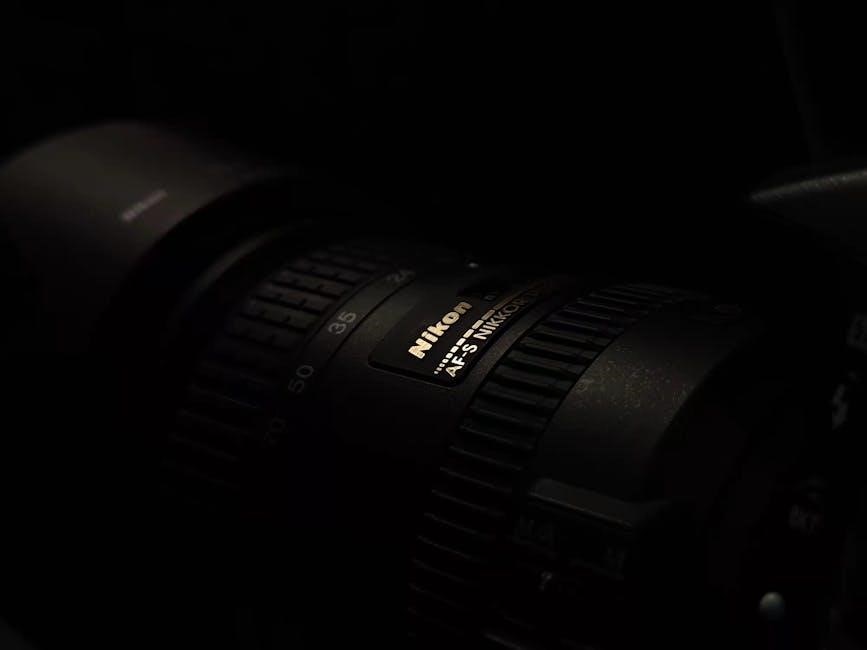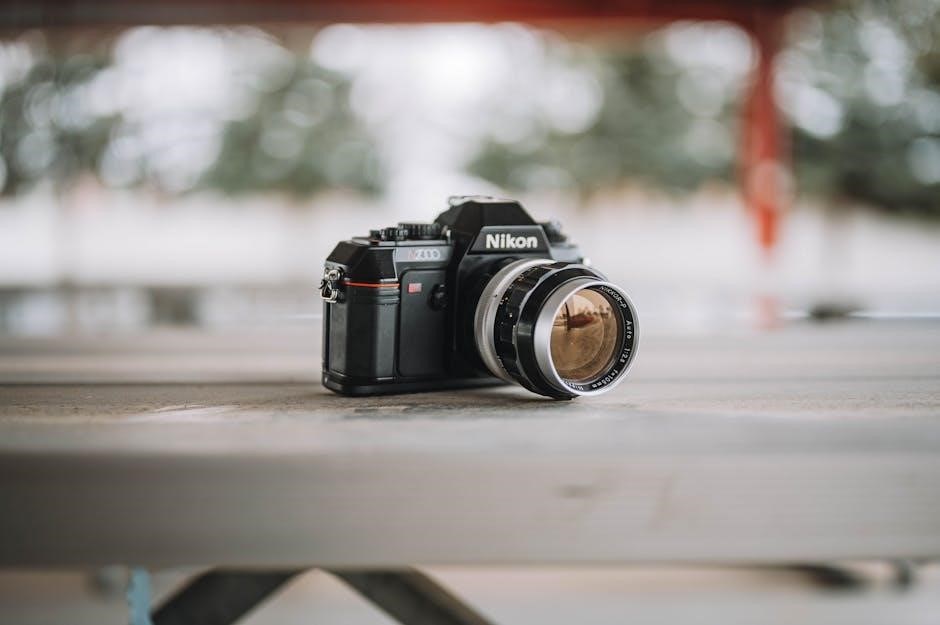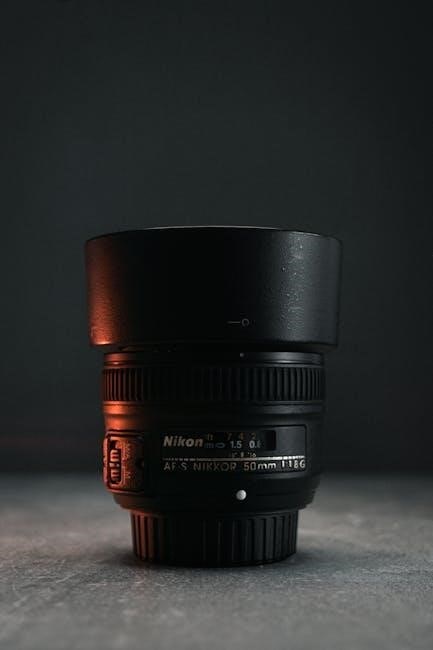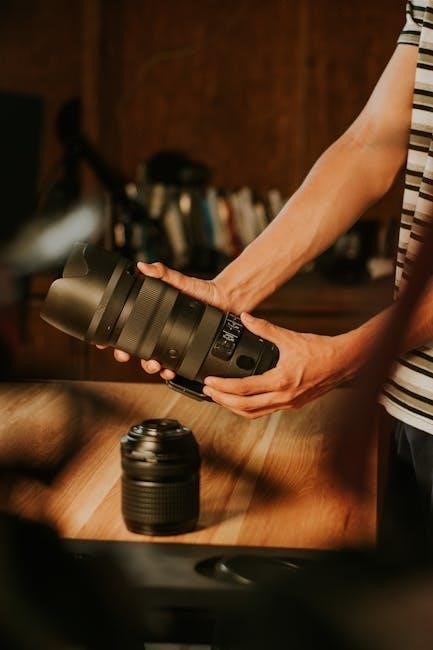The Nikon D610 manual is your ultimate guide to mastering this powerful DSLR camera. It covers essential features, settings, and shooting techniques to enhance your photography experience.
1.1 Overview of the Nikon D610 Camera
The Nikon D610 is a full-frame DSLR camera designed for professional and enthusiast photographers. It features a 24.3-megapixel CMOS sensor, delivering high-resolution images with excellent detail. The camera supports continuous shooting at 6 frames per second and records Full HD 1080p video. With an ISO range of 100-6400 (expandable to 50-25,600), it excels in low-light conditions. The D610 includes a 39-point autofocus system, dual SD card slots, and compatibility with Nikon’s extensive range of F-mount lenses. Its durable construction and intuitive controls make it a versatile tool for various photography genres, from landscapes to portraits.
1.2 Importance of the Manual for Optimal Camera Use
The Nikon D610 manual is essential for unlocking the camera’s full potential. It provides detailed explanations of advanced features, customization options, and shooting modes, ensuring users can make the most of their equipment. By understanding settings like Picture Control, autofocus customization, and video recording options, photographers can enhance image quality and achieve their creative vision. The manual also serves as a reference for troubleshooting common issues and maintaining the camera’s performance. Whether you’re a novice or an experienced photographer, the manual is a vital resource for mastering the D610 and improving your photography skills effectively.

Camera Components and Exterior Features
The Nikon D610 features a durable magnesium alloy body, weather-sealed design, and a 3.2-inch LCD screen. Exterior controls include mode dials, AF buttons, and customizable dials.
2.1 Exterior Controls and Buttons
The Nikon D610 features an intuitive layout with exterior controls designed for easy access. The mode dial on the top allows quick switching between shooting modes, while the AF buttons enable precise autofocus control. Customizable dials let you adjust aperture, shutter speed, and exposure compensation effortlessly. The shutter release is ergonomically placed for comfortable shooting. Additional buttons like the live view and playback controls are strategically positioned for seamless navigation. The weather-sealed design ensures durability, while the textured grip enhances handling. These exterior controls empower photographers to make quick adjustments, ensuring optimal performance in various shooting scenarios.
2.2 Understanding the Camera’s Layout
The Nikon D610’s layout is designed for intuitive operation, with ergonomically placed controls that enhance shooting comfort. The weather-sealed body ensures durability, while the textured grip provides a secure hold. Key components like the LCD screen, viewfinder, and mode dial are strategically positioned for easy access. The camera’s balance and weight distribution make it comfortable to handle, even during extended shoots. The layout prioritizes functionality, allowing photographers to quickly adjust settings without distractions. This thoughtful design ensures seamless navigation, enabling users to focus on capturing high-quality images in any setting.
2.3 Key Features of the Nikon D610
The Nikon D610 boasts a 24.3-megapixel full-frame CMOS sensor, delivering exceptional image quality with fine details and vibrant colors. It supports continuous shooting at up to 6 frames per second, making it ideal for capturing dynamic moments. The camera features an ISO range of 100-6400, expandable to 50-25,600, ensuring versatility in low-light conditions. Full HD 1080p video recording is available at 24, 25, or 30 FPS, with manual controls for precise adjustments. The D610 also includes weather-sealing for durability, dual SD card slots for storage flexibility, and a 100% coverage optical viewfinder for accurate framing. Its ergonomic design and robust feature set make it a versatile tool for enthusiasts and professionals alike.

Camera Modes and Shooting Options
The Nikon D610 offers various modes, including Auto, Scene, and PASM (Program, Aperture Priority, Shutter Priority, Manual), plus customizable U1, U2, and U3 settings for tailored shooting experiences.
3.1 Auto Mode and Scene Modes
The Nikon D610 features an intuitive Auto Mode that simplifies photography by automatically adjusting settings for optimal results. For more control, Scene Modes cater to specific situations like Portrait, Landscape, and Night Portrait, optimizing camera settings to capture the best possible images. These modes are designed to make photography accessible for beginners while still offering flexibility for experienced users. By leveraging Scene Modes, photographers can achieve professional-quality shots without manually adjusting complex settings, ensuring crisp and vibrant images in various lighting conditions and scenarios.
3.2 Understanding PASM Modes (Program, Aperture Priority, Shutter Priority, Manual)
PASM modes on the Nikon D610 offer advanced control for photographers. Program Mode balances exposure automatically, while Aperture Priority (A/Av) allows control over depth of field by adjusting the aperture. Shutter Priority (S/Tv) enables control over motion capture by setting the shutter speed. Manual Mode (M) provides full control over exposure by adjusting both aperture and shutter speed. These modes empower photographers to tailor settings to their creative vision, offering flexibility for diverse shooting scenarios and lighting conditions. Mastering PASM modes enhances creativity and ensures precise control over image capture.
3.3 Custom Shooting Modes (U1, U2, U3)
The Nikon D610 offers three custom shooting modes—U1, U2, and U3—allowing photographers to save personalized settings for quick access. These modes let you store configurations for aperture, shutter speed, ISO, white balance, and other preferences tailored to specific shooting scenarios. Saving settings is simple: configure the camera as desired, then save to U1, U2, or U3 via the menu. This feature is ideal for photographers who frequently shoot in consistent environments or styles, enabling rapid adjustments and streamlined workflows. Custom modes enhance efficiency and ensure consistent results in various creative or technical photography applications.
Customization and Settings
The Nikon D610 offers extensive customization options, including Picture Control settings, autofocus adjustments, and custom menus. These features allow photographers to tailor the camera to their preferences, enhancing creativity and efficiency for optimal image results.
4.1 Picture Control Settings
The Nikon D610’s Picture Control settings allow photographers to customize image output by adjusting parameters like sharpening, contrast, brightness, and saturation. These settings enable the creation of unique styles, from vivid landscapes to moody portraits. The camera offers several preset Picture Controls, including Standard, Neutral, Vivid, and Monochrome, each designed for specific artistic effects. Users can also create and save custom Picture Controls, ensuring consistent looks across projects. Additionally, adjustments can be made using the in-camera menu system or through external software like ViewNX-i, providing flexibility for both in-camera and post-processing workflows.
4.2 Customizing Autofocus and Metering
The Nikon D610 allows for precise customization of autofocus and metering settings, enabling photographers to tailor the camera to their shooting style. The autofocus system features 39 focus points, which can be adjusted to prioritize specific areas or subjects. Users can choose between Single Servo AF and Continuous Servo AF modes, depending on whether they’re capturing stationary or moving subjects. Metering options include 3D Color Matrix II, Center-Weighted, and Spot metering, each suited for different lighting conditions. Customizing these settings ensures accurate focus and exposure, allowing photographers to achieve their creative vision with ease and precision.
4.3 Configuring Custom Menus
The Nikon D610 offers customizable menus, allowing photographers to streamline their workflow by accessing frequently used settings quickly. Users can create up to three custom menu banks, each tailored to specific shooting scenarios. This feature enables easy organization of preferred options, reducing time spent navigating through menus during a shoot. Additionally, customizing the “My Menu” option lets photographers add their most-used settings for rapid access. This level of personalization enhances efficiency, ensuring that the camera adapts to individual preferences, making the shooting experience more intuitive and productive for photographers of all levels.

Technical Specifications and Image Quality
The Nikon D610 features a 24.3MP full-frame sensor, delivering exceptional image quality with vibrant colors and sharp details. It supports 6 FPS continuous shooting and Full HD video recording, offering versatility for both stills and motion capturing, while its ISO range ensures performance in various lighting conditions.
5.1 Sensor and Image Resolution Details
The Nikon D610 is equipped with a 24.3-megapixel full-frame CMOS sensor, measuring 35.9mm x 24.0mm, ensuring exceptional image quality and low-light performance. The sensor captures images at a maximum resolution of 6016 x 4016 pixels, delivering crisp and detailed shots. Paired with Nikon’s EXPEED 3 image-processing engine, the camera enhances color accuracy and reduces noise, especially in high-ISO settings. The sensor’s full-frame design allows for a shallow depth of field and superior light gathering, making it ideal for professional photographers and enthusiasts seeking high-resolution results. This combination ensures the D610 produces stunning images across various lighting conditions.
5.2 ISO Range and Noise Performance
The Nikon D610 features an ISO range of 100 to 6400, expandable to 25600 in Hi mode, offering flexibility in various lighting conditions. The camera excels in low-light photography, with minimal noise visible at higher ISO settings due to its advanced EXPEED 3 image-processing engine. Fine-grained noise is well-controlled up to ISO 12800, making it suitable for professional use. The D610 balances noise reduction and detail retention effectively, ensuring sharp and clean images even in challenging environments. This capability makes it a reliable choice for photographers capturing portraits, landscapes, and action shots in diverse lighting scenarios.
5;3 White Balance and Color Accuracy
The Nikon D610 offers precise white balance settings, ensuring accurate color reproduction in various lighting conditions. With options like Auto, Direct Sunlight, Shade, and custom settings, users can achieve natural hues and consistent results. The camera’s EXPEED 3 processor enhances color accuracy, delivering vibrant yet realistic tones. Skin tones are rendered faithfully, and the ability to fine-tune settings allows for personal creative control. Additionally, the D610 supports Picture Control settings, enabling adjustments to contrast, saturation, and sharpening for tailored color output. This ensures images are sharp, vivid, and true to life, meeting the demands of professional photographers and enthusiasts alike.

Lenses and Accessories
Explore the wide range of compatible lenses and accessories for the Nikon D610, including FX and DX lenses, Lens Station, hoods, and caps, to enhance your photography experience. Refer to the Nikon D610 manual for detailed compatibility and usage guidelines.
6.1 Compatible Lenses for the Nikon D610
The Nikon D610 is compatible with a wide range of lenses, including FX and DX formats. FX lenses are designed for full-frame sensors, offering superior image quality and wider angles. DX lenses, while optimized for APS-C sensors, also work on the D610 with a 1.5x crop factor. Additionally, the camera supports AF-S, AF-P, and older AF lenses, ensuring versatility for various photography needs. The manual provides detailed information on lens compatibility and usage, helping users make informed choices to enhance their creative possibilities.
6.2 Recommended Accessories for Enhanced Functionality
To maximize the Nikon D610’s potential, consider essential accessories. A sturdy tripod ensures stability for low-light shots, while high-speed memory cards enhance workflow efficiency. External flashes, like the SB-700, offer advanced lighting control. Protective cases and lens cleaning kits maintain equipment condition. Remote shutter releases and battery grips extend shooting capabilities. Additionally, compatible filters and lens hoods can improve image quality and reduce glare. These accessories, detailed in the manual, help photographers tailor their setup to specific needs, ensuring optimal performance and creativity in various shooting scenarios.
6.3 Using Nikon’s Lens Station and Other Accessories
Nikon’s Lens Station is a versatile tool designed to enhance lens performance and camera functionality. It allows for firmware updates, customizations, and detailed lens adjustments. The manual provides step-by-step guidance on connecting lenses to the station and performing diagnostics. Other accessories, such as the optional MB-D14 battery grip, extend shooting sessions and improve ergonomics. The Lens Station ensures compatibility and optimal performance, while additional accessories like remote controllers and GPS units expand the D610’s capabilities. These tools, as outlined in the manual, empower photographers to achieve professional-grade results with precision and ease.

Shooting Techniques and Tips
Master essential techniques to elevate your photography. Focus on composition, lighting, and subject interaction. Experiment with modes and settings to capture stunning images effortlessly.
7.1 Mastering Autofocus for Sharp Images
Mastering autofocus on the Nikon D610 ensures sharp, precise images. Use Single AF for stationary subjects and Continuous AF for moving ones. The AF lock button helps maintain focus. Customize AF modes to suit your needs, and experiment with dynamic AF area modes for better subject tracking. Regularly calibrate your lenses for optimal performance. Adjust AF sensitivity and release timing in the custom menu for improved results. Practice using back-button focusing for enhanced control over focus acquisition. Clean the camera’s AF sensor regularly to avoid dust interference. These techniques will help you achieve razor-sharp images consistently.
7.2 Optimizing Video Recording Settings
Optimizing video settings on the Nikon D610 enhances your filmmaking experience. Set resolution to 1080p at 24 or 30 fps for cinematic quality. Use manual focus or enable AF-F for smooth transitions. Adjust white balance to match lighting conditions, and utilize Picture Controls for consistent color profiles. Enable wind noise reduction and attach an external microphone for clearer audio. Stabilize footage with a tripod or handheld rig. Experiment with frame rates and exposure settings to achieve desired effects. Regularly update firmware to access new video features and improvements. These adjustments ensure professional-grade video capture with the D610.

Maintenance and Firmware Updates
Regular maintenance ensures optimal performance of your Nikon D610. Clean the sensor and camera body, and update firmware for improved functionality and new features. Proper care extends longevity.
8.1 Cleaning and Maintaining the Camera
Regular cleaning and maintenance are crucial for the Nikon D610’s performance. Use a soft, dry cloth to wipe the camera body and lens. For the sensor, use Nikon-approved cleaning tools like a blower or swabs. Avoid touching the sensor to prevent damage. Clean the mirror and viewfinder gently with a microfiber cloth. Store the camera in a cool, dry place to prevent humidity damage. Regular maintenance ensures sharp images and optimal functionality. Always refer to the manual for detailed cleaning instructions to avoid damaging sensitive components.
8.2 Updating Firmware for Improved Performance
Updating the Nikon D610’s firmware ensures optimal performance and access to new features. Visit Nikon’s official website to download the latest firmware version. Connect the camera to your computer via USB and follow the on-screen instructions. Ensure the camera is fully charged or use an AC adapter to prevent interruptions. Do not disconnect the camera or turn it off during the update, as this could cause permanent damage. After completion, restart the camera to apply the updates. Regular firmware checks help maintain camera functionality and compatibility with lenses and accessories, ensuring the best photography experience. Always use Nikon-approved firmware for safety.

Troubleshooting Common Issues
Troubleshooting common issues with the Nikon D610 ensures uninterrupted photography sessions. Check error messages, reset settings, clean the sensor, and update firmware for optimal performance and reliability.
9.1 Resolving Error Messages
Encountering error messages on your Nikon D610? Common issues include “ERR” due to lens or settings problems, or “CARD” for memory card errors. Always check connections and restart the camera. For firmware-related errors, update to the latest version. If issues persist, reset the camera to default settings or perform a factory reset. Refer to the manual for specific error code solutions. Regular maintenance, such as cleaning the sensor and updating firmware, can prevent many issues. If problems remain unresolved, contact Nikon support for professional assistance.
9.2 Fixing Common Camera Malfunctions
Common malfunctions with the Nikon D610 include issues like the shutter release not responding or the mirror sticking. For shutter problems, clean the release button gently with a soft cloth. If the mirror locks up, reset the camera to factory settings or update the firmware. Autofocus malfunctions can often be resolved by recalibrating the lens or cleaning the AF sensor. For persistent issues, perform a factory reset or consult the manual. Regularly cleaning the camera’s sensor and using genuine Nikon accessories can prevent many malfunctions. If problems persist, contact Nikon support for professional repair.

Resources and Further Learning
Explore official Nikon resources, downloadable manuals, and recommended books for in-depth learning. Online forums and workshops offer additional tips and troubleshooting guides for the D610.
10.1 Downloading the Nikon D610 Manual
The Nikon D610 manual is readily available for download from Nikon’s official website as a PDF file. This comprehensive guide covers all features, settings, and troubleshooting tips. Users can access it through the Nikon Manual Viewer app for iOS and Android devices, ensuring easy reference anytime. Additionally, third-party websites offer downloadable versions, providing quick access to detailed instructions. Ensure to verify the source for authenticity to avoid outdated or incorrect information. Downloading the manual is a great way to familiarize yourself with the camera’s capabilities and optimize your photography skills.
10.2 Recommended Books and Guides for the D610
Several books and guides are available to deepen your understanding of the Nikon D610. Titles like The Complete Nikon Manual and specialized eBooks provide detailed insights into camera functions. These resources often include practical tips, shooting techniques, and troubleshooting advice. Many are available in PDF format, making them easily accessible. Nikon’s official website and third-party platforms offer downloadable guides tailored for the D610. Whether you’re a beginner or an advanced photographer, these resources complement the manual, offering in-depth knowledge to help you master your camera’s capabilities and improve your photography skills effectively.
The Nikon D610 manual serves as a comprehensive guide to unlocking your camera’s full potential. By mastering its features and staying updated, you can enhance your photography skills and creativity.
11.1 Final Tips for Getting the Most Out of the Nikon D610
To maximize your Nikon D610’s performance, experiment with custom settings and Picture Controls. Regularly update firmware and maintain the camera to ensure optimal functionality. Explore various lenses and accessories to expand your creative possibilities. Practice shooting in different modes and review your work to refine your techniques. Staying informed about new features and techniques through Nikon’s resources will help you stay ahead in your photography journey. By combining these strategies, you can fully utilize the D610’s capabilities and achieve exceptional results in every shot.
11.2 Staying Updated with Nikon’s Latest Features
Stay informed about Nikon’s latest updates by regularly checking their official website and downloading firmware improvements. Subscribe to Nikon’s newsletters and explore resources like ViewNX 2 for software updates. Utilize Nikon’s Manual Viewer 2 app for on-the-go access to guides. Additionally, refer to downloadable PDF manuals and user guides for detailed insights. Engage with photography communities and forums to learn from experienced users. By staying updated, you can unlock new features, enhance performance, and make the most of your Nikon D610. This proactive approach ensures you always have the latest tools and knowledge at your fingertips.

Glossary of Terms
This section provides clear definitions of key photography terms, Nikon-specific terminology, and technical jargon used throughout the manual, ensuring a comprehensive understanding of the D610’s features and functions.
12.1 Key Photography Terms Explained
This section defines essential photography terms to help you understand the Nikon D610’s features and functions. Aperture refers to the lens opening that controls light entry, while shutter speed is the duration the camera’s shutter remains open. ISO sensitivity adjusts the camera’s light response, and white balance corrects color casts based on lighting conditions. Additional terms like RAW (unprocessed image files), burst mode (continuous shooting), and depth of field (subject focus range) are also explained to enhance your photography skills with the D610.
12.2 Nikon-Specific Terminology
This section explains Nikon-specific terms crucial for mastering the D610. Picture Control allows customization of color and tone in images. AF Fine Tune adjusts autofocus precision for lenses. i-TTL (Intelligent Through-The-Lens) flash metering ensures accurate flash exposure. Nikon Scene Modes simplify shooting in specific conditions like portraits or landscapes. Terms like Custom Settings and Menu Options refer to the camera’s programmable features. Understanding these terms enhances your control over the D610’s advanced capabilities, optimizing your photography workflow and creativity.
